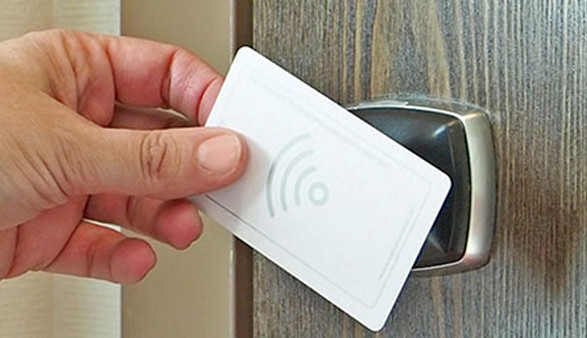4 Types of Key Card Entry System to
The Key Card Entry System is very similar to the Key Fob Entry System with some differences. It be turned into an ID card for visual identification and electronic authentication. Cards can also be swiped or scanned in places where fobs are typically only used as proximity readers.
1. Key card
Key cards can come in a variety of formats, but the most common are smart cards or proxy cards.
2. Smart card
Smart cards are a proprietary format designed to have a higher level of security than traditional proxy cards. Smart cards are more difficult to “clone” or crack than proxy cards. Since a smart card is only designed to communicate with a very specific card reader, it does not allow the transfer of an old card from an old entry system to a new one.
In the context of credentials, the term “smart card” generally refers to a high-frequency RFID card that transmits data using near field communication. NFC technology operates at 13.56 MHz and is commonly found in contactless payment systems. They still use passive inductive power, but smart cards have a larger storage capacity than 125kHz cards, so they can encrypt data in addition to storing it. Therefore, they are more secure and not as easy to duplicate as the old proxy cards. Smart card door locks also typically have a smaller working radius than traditional RFID access control systems, up to about 4 inches.
3. Proxy card
Many access control administrators choose proximity cards in mixed-use buildings that use traditional hardware or in mixed-use buildings where cardholders may have credentials for other doors, usually in proximity format. The convenience of the redundant nature of proxy cards from one system to another makes them an easy choice when high security is not required.
Contactless credentials typically use radio frequency identification to transmit data stored on microchips. The Prox card communicates with the reader using a low frequency of 125 kHz. The card can be actively powered by a small lithium battery or, more commonly, passively by a card reader, which continuously emits a short-range radio signal. When the card is close enough, the card’s coil antenna stores enough energy to send the ID on the chip to the waiting reader. Prox cards are proprietary, so there is no established standard or compatibility between manufacturers. They are also easily copied or rewritten, although you must be within the card’s read radius (about 1 foot) to do so.
4. Wiegand Card
Some of the first key cards developed for key card systems were Wiegand cards, named after their inventor. In the 1970s, John R. Wiegand discovered that specially annealed wires made of iron, cobalt, and vanadium would suddenly change polarity when passed through a sufficiently strong magnetic field. A nearby sensor coil will receive rapid changes in high-voltage pulses, which can be converted into data if multiple wires pass through the field. Wiegand key cards use two short parallel Wiegand wires to store binary data with magnetic polarity. When the card is pulled through the card reader, the wire is recorded as a 1 and the blank spot is recorded as a 0. The unique Wiegand number is then sent to the controller for verification.


 Shelley
Shelley Nielsen
Nielsen